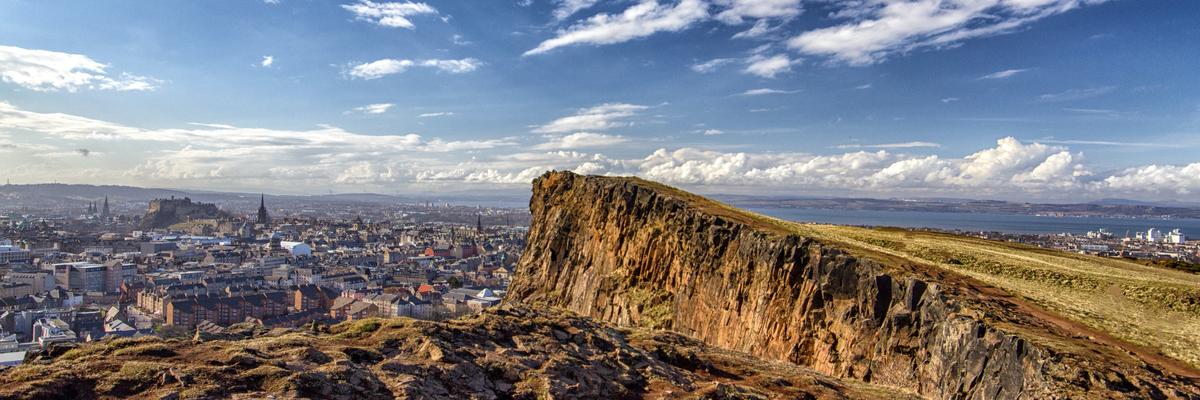Commentary
Dr Kate Crowley
24 May 2021
“This is a city of shifting light, of changing skies, of sudden vistas. A city so beautiful it breaks the heart again and again.” Alexander McCall Smith[1]
Recently I walked across the Braid Hills in Edinburgh. The view is spectacular with the city laid out below in all its historic glory. From the Castle to Arthur’s Seat, this city is a gem in our cultural heritage. The Old and New Towns of the city have global recognition as UNESCO World Heritage Sites and it was the first UNESCO City of Literature.
What does this mean in terms of how we value the city? Do we care if sea level rise erodes the coastline and floodwaters destroy or damage historic buildings? Does it matter if heatwaves mean that the festivals are impossible to run? I hope the answers are yes. The city is not only a home and a source of our livelihoods but also represents the history of those who, over the centuries, lived here and spread their expertise and experience around the world.
Yet, despite our heritage being a source of inspiration, livelihoods and significance, it is often missing in discussions on climate change, risk assessment and adaptation decisions. Globally, the value and significance of heritage, both tangible (e.g. structures and physical sites) and intangible (e.g. customs, languages and beliefs) are rarely considered in risk assessments that are required for effective decision-making.
Fortunately, for Edinburgh, the Place-based Climate Action Network (PCAN) is part-funding Edinburgh World Heritage to implement a community based climate risk assessment that is specifically engaging with those who live across the city. This novel project aims to understand how people value heritage and incorporate this understanding into risk assessments to support new adaptation plans.
Why consider heritage for adaptation?
Heritage encapsulates our history, our customs and our beliefs and therefore shapes our future. Heritage is so fundamental to how we behave that it is a crucial consideration for effective adaptation and disaster management.
Cultural heritage influences who is impacted by hazards and why. For example, here in the UK and elsewhere, people buy houses on exposed coastal cliff edges because as a society we value a view of the ocean and access to beaches. In Bangladesh, traditional customs mean that women are not allowed to leave their homes without permission from a male head of household, putting them in significant danger during cyclones as they cannot evacuate easily.
As climate change brings increasingly severe hazards, such as floods and droughts, our ability and willingness to adapt is fundamentally framed within our experiences and our culture. Therefore, our heritage is also a source of resilience. Cultural beliefs bring communities together and strengthen their cohesion and communication, a core characteristic of a resilient community. Traditional adaptation mechanisms are forged by evolving cultural heritage.
However, the discourse on heritage and climate change, that do exist, focus on preservation. Yet some academics argue that heritage is dynamic, and our attempts to preserve heritage are flawed. This debate highlights the need to not only focus on risk assessment for one site or structure for its preservation but rather understand heritage for the adaptation of the local community.
The variety of heritage means that it is both essential, yet problematic, to incorporate within conventional risk assessments for adaptation. For example, how can you capture the vulnerability and influence of both tangible and intangible heritage?
Incorporating heritage within risk assessment
Given these complexities, it is important to learn the lessons of the past.
A systematic literature review of academic papers exploring heritage and risk assessment has found a significant lack of community involvement in the inclusion of heritage within risk assessment. Those studies that specifically carry out risk assessments for heritage sites are generally focussed on the exposure of physical structures from hazards. They rarely attempt to understand the value or significance of that site and none of the papers reviewed include perspectives or engagement by local communities.
Where a consultation on value has taken place, it has been with experts such as academics or professionals working in the heritage sector. This means that the resulting assessments are limited. And, although many papers mention the importance of intangible heritage such as language, customs and belief, none of the selected papers attempt to capture this in any way.
Another interesting aspect of the papers reviewed show a considerable geographical skew. The majority of studies explore impacts or exposure to hazards on physical structures in Europe or the United States of America and very few attempt to apply methods elsewhere.
Understanding the value of heritage in context
The literature review is part of a new research project that will attempt to address these gaps by working across Sri Lanka, South Africa and Indonesia to better understand the value and significance of heritage in context. This place-based study emphasises the need for sharing the diversity of experiences and methods for understanding the impacts of natural hazards, including climate change on heritage and the influence of heritage on our ability to adapt.
Back in Scotland, the Edinburgh World Heritage team have started to address these global challenges by engaging local communities to better understand their values for improved climate risk assessment. They are breaking new ground by facilitating a series of virtual workshops that provide space for local communities to share their views on heritage as well as past and future climate risk so that, together, we can create a resilient city.
Dr Kate Crowley, PCAN Associate and Lecturer in Climate Risk and Resilience, Co-Director of Edinburgh Climate Change Institute, University of Edinburgh
Acknowledgement: This commentary is based on preliminary findings from a literature review undertaken as part of the GCRF AHRC funded project called CRITICAL: Threats to Cultural Heritage resulting from Natural Disasters and Climate Change as well as reflections from the Edinburgh World Heritage Climate Change Risk Assessment project.
[1] This quote of his has been used as part of an art installation to promote Edinburgh’s status as the first UNESCO City of Literature.
Image: Photo by Yves Alarie on Unsplash

